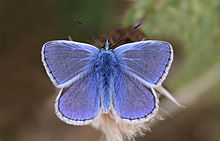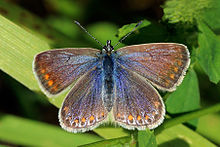Common blue
| Common blue | |
|---|---|
 |
|
| Male | |
 |
|
| Female both in Oxfordshire |
|
| Scientific classification | |
| Kingdom: | Animalia |
| Phylum: | Arthropoda |
| Class: | Insecta |
| Order: | Lepidoptera |
| Family: | Lycaenidae |
| Tribe: | Polyommatini |
| Genus: | Polyommatus |
| Species: | P. icarus |
| Binomial name | |
|
Polyommatus icarus (Rottemburg, 1775) |
|
The common blue (Polyommatus icarus) is a butterfly in the family Lycaenidae.
Subspecies include:
This species is widespread over much of the Palaearctic in temperate Asia and Europe. These butterflies inhabit flowery or grassy places, warm and cool, open or wooded areas and at all altitudes up to high alpine meadows at an elevation of 0–2,700 metres (0–8,858 ft) above sea level.
The common blue is Britain's (and probably Europe's) most common and most widespread blue. It is found as far north as Orkney and on most of the Outer Hebrides. A range of grassland habitats are used: meadows, coastal dunes, woodland clearings, and also many man-made habitats, anywhere their food plants are found.
It is a recently introduced species in eastern Canada. The common blue butterfly was discovered in Mirabel, Quebec, Canada, by Ara Sarafian, an amateur entomologist who observed the butterfly from 2005 to 2008. He contacted the Canadian National Collection of Insects in Ottawa where the butterfly was identified as Polyommatus icarus, a new alien butterfly to Canada and to North America. The butterfly seems to be well established and is extending its range from year to year. In 2016 pictures were taken of a male butterfly in the forest near Kamloops, British Columbia.
Polyommatus icarus has a wingspan of 28–36 millimetres (1.1–1.4 in). This species is very variable, depending on location. Common blue males usually have uppersides in an iridescent lilac blue with a thin black border. Females are brown above with a row of red spots along the edges and usually some blue at the base of the wings; the extent of blue and brown is extremely variable; the upperside may be mostly blue, especially in Ireland and Scotland, but it always has red spots. Undersides have a greyish ground colour in the males and a more brownish in the females.
Both sexes have a row of red spots along the edge of the hindwings and extending onto the forewings, though they are generally fainter there, particularly in the males, where they are sometimes missing altogether. There are about a dozen black-centred white spots on the hindwings, nine on the forewings. These usually include one in the middle of the forewing cell, absent in Chapman's and Escher's blues. The fringes on the outer edge of the wings are uniform white, not crossed with black lines(lack checkering) , as it is in the chalkhill blue and Adonis blues.
...
Wikipedia
